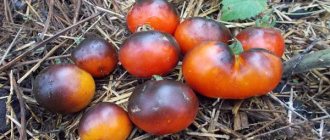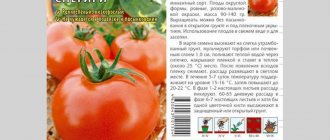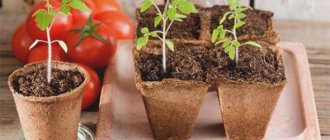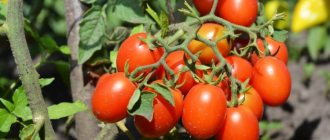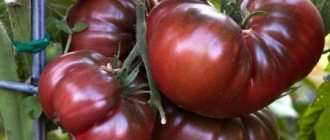Characteristics of tomato Altai honey
Tomato plants of the Altai honey variety grow up to 1.5 m in open ground. In greenhouses, the determinate tomato grows higher. The leaves are of the usual type, long, medium in size, not dense. For good development, tall, large-fruited tomatoes are tied up. Mandatory care includes stepsoning. Gardeners recommend growing plants of a productive variety with two stems. Intermediate inflorescences are formed on plants. Each cluster bears 5-6 fruits, even and identical, with an average weight of 250-400 g.
Many people like the warm, bright orange color of the skin and pulp of Altai honey tomatoes. A spot near the stalk of a rich green color, which stands out on unripe tomatoes, is not visible on ripe ones. The color is apricot-yellow, uniform. The fruits are rounded at the stalk, heart-shaped, slightly ribbed. The skin is smooth, dense, and does not crack. The juicy pulp is fleshy, of medium density, with 4-6 large seed chambers. Altai honey tomatoes, according to descriptions and reviews, contain few seeds.
According to its characteristics, the Altai salad honey variety is ideal for fresh consumption. Excess fruit is suitable for processing for the winter: raw material for assorted salads, juices, pastes, purees. The plant is classified as an early ripening plant; tomatoes are harvested 90-105 days after the sprouts appear. If the seeds for seedlings were sown in February, the first harvest is harvested in July.
Planting dates and care
The Altai honey variety should take 55-60 days from the moment of germination to transplantation into the soil. Sowing time depends on the region and weather forecasts; for greenhouses you can focus on the following dates:
- south - end of February;
- Middle zone - from early to mid-March;
- Siberia, North-West - end of March.
For open ground, seeds are sown approximately 2 weeks later. Seedlings are transplanted when the ground warms up:
- up to 10° C – in a greenhouse;
- 15° C and above – go to the garden.
Planting scheme when driving in 2 trunks:
- in protected ground - 70-90 cm between rows, bushes at a distance of 50-60 cm;
- for open – 100 and 70 cm, respectively.
Caring for Altai honey is not much different from other tall tomatoes:
- mulch the bed - this will save moisture and prevent the soil from overheating and weeds from germinating;
- water moderately and evenly to prevent cracking of the fruit;
- fed with complex fertilizers - first with a predominance of nitrogen, then phosphorus and potassium;
- microelements are given by spraying through a leaf apparatus;
- carry out preventive treatments;
- the bush is tied to a strong support;
- stepchildren pluck in a timely manner;
- remove the leaves under the tassels that have begun to fill;
- harvest;
- after the formation of 5-6 clusters, the shoots become blind.
When truncating tomatoes in southern greenhouses, you can leave more trusses.
Pros and cons of the Altai honey tomato variety
According to the characteristics and description of the variety, the Altai honey tomato has many advantages in cultivation:
- excellent taste properties;
- large-fruited;
- not prone to skin cracking;
- productive;
- spectacular appearance of the fruit;
- transportable;
- early ripening;
- disease resistant.
Among the disadvantages of Altai honey tomatoes, which are recommended to be grown in the middle zone in greenhouses, are:
- the need to form a bush for the appropriate harvest;
- mandatory installation of supports or trellises for tall varieties;
- carrying out regular fertilizing;
- in open ground in some areas tomatoes do not have time to ripen.
Yellow tomatoes protect your health
The yellow and orange color of the fruit is the result of a combination of yellow and orange colored pulp and colorless or yellow skin. Various shades of color - from moon-wax to bright orange "a la Fanta" - are the result of the superposition of shades of skin and pulp, which, in turn, depend on the saturation of the tissues with such an important substance as beta-carotene .
As you know, carotenoids - substances responsible for the color of fruits - are powerful antioxidants. The importance of antioxidants for human life and health cannot be overestimated. The mechanism of their action is associated with reducing harm from oxidative processes, which lead to aging of the body and decreased immunity.
The most powerful antioxidant is lycopene , a carotenoid responsible for its red color. However, it can be an allergen for some people, which is where beta-carotene . And yellow tomatoes contain a minimum of lycopene and a lot of beta-carotene, which is also provitamin A , which is converted in the human body directly into vitamin A itself.
Consequently, by consuming yellow and orange tomato fruits, we take advantage of the full power of the antioxidant beta-carotene, which helps prevent cardiovascular diseases and even some cancers, and the entire “range of services” provided by provitamin A, including the prevention of cataracts and other degenerative changes in the visual organs . In addition, vitamin A is essential for bone health, healthy skin, hair, and immune system function.
Growing
The yield of Altai honey tomatoes, according to reviews and photos, is achieved by complying with the requirements of agricultural technology when planting and caring for tall plants.
Growing seedlings
In order to get a harvest of orange tomatoes in mid-summer, you need to sow the seeds from late February or early March. For the initial phase of seedlings prepare:
- plastic, ceramic or wooden containers with holes at the bottom;
- purchased universal soil or a self-prepared substrate of peat and sand in equal parts;
- phytolamps for additional illumination of sprouts in cloudy weather.
The seeds are deepened into the soil by 0.5-1 cm. The container is covered with glass or plastic film and placed near the battery so that the temperature in the container does not drop below 20 °C. Tomatoes germinate in 6-7 days. Having seen the first shoots, the shelter is removed from the container and transferred to a cooler but brighter place. With a temperature of 18 °C and sufficient lighting, at least 12 hours per day, the seedlings become strong within a week. Then the temperature is gradually increased to a comfortable level for tomatoes of 23-25 °C.
When the first or second true leaf appears on the sprouts, they are picked: transplanted into separate cups. The tomatoes will grow in the container until they are planted in a permanent place in a greenhouse or garden. When growing seedlings, check the condition of the soil every day. The substrate should be moderately moist; the soil should not be allowed to dry out.
Important! During seedling development, special attention is paid to maintaining moderate soil moisture, comfortable air temperature and bright lighting.
Landing rules
Tomato seedlings are moved to a permanent place after 55-60 days of development. At this point, the plants are 25-30 cm high, with 8-9 leaves formed and the first fruit raceme being formed. It is recommended to plant no more than 3 Altai honey tomato plants per 1 square meter, both in a greenhouse and in open ground. Supports are immediately installed: strong pegs, 1.2-1.5 m high, or trellises are constructed. In the garden, the support is installed at least 10 cm from the stem.
When landing, adhere to the following requirements:
- dig spacious planting holes so that the root system of tomatoes can freely fit in them along with a lump of earth;
- pour up to 1 liter of water into the wells;
- the seedling is placed in the hole when the water is completely absorbed;
- compact the soil around the root and sprinkle it with soil to the level of the garden.
Attention! You can add 1 tablespoon of ammonium nitrate to the hole for strength and powerful growth of seedlings.
Watering and fertilizing
Water the tomato seedlings after a few days. In the garden they are guided by the weather - in 3 or 5 days. The bushes are watered in the evening with warm water that has settled during the day. Pour at least 1 liter of water under each tomato. Tomatoes need sufficient moisture during the period of bud formation, flowering and fruit production.
Altai honey tomatoes are fertilized with mineral and organic substances. The first fertilizing is applied 2 weeks after planting the tomatoes. The mullein solution is diluted with water in a ratio of 1:5. The following feedings are also carried out at intervals of 14-17 days. Various complex mineral fertilizers are used:
- "Fertika";
- "Crystalon";
- nitrophoska or nitroammofoska and others.
Advice! Supporting tomato yields by foliar fertilizing with boric acid is popular for its effectiveness.
Pinching and tying
Tall Altai honey bushes need stem staking. The shoots are tied with light material that will not injure the delicate tissues of the plant. In addition to the stems, fruit clusters are also tied up, because they are usually heavily loaded with harvest. Good development of a tomato plant is impossible without pinching. The shoots in the leaf axils are removed systematically. Stepchildren are not allowed to grow more than 7-8 cm. When breaking off, a stump 1 cm long is left to stop the creation of a new shoot.
Formation
The productivity of tall, large-fruited tomatoes Altai honey of Siberian selection depends on the competent formation of plants. From the beginning of the development of the bush, choose a strong first or second stepson from the bottom and lead it with a separate stem. Gardeners claim that the best results are obtained from those bushes that are formed into two stems. When 4-5 clusters are created on both shoots, pinch off the tops of the stems. This procedure helps the plant direct energy to fill and ripen the already formed fruits. In open ground conditions, it is advisable to do pinching after 3-4 fruit clusters, so that the tomatoes have time to ripen during the hot season.
Protection from diseases and pests
The variety is resistant to fungal diseases, and to prevent them:
- the greenhouse is regularly ventilated;
- remove the lower wilted leaves;
- tomatoes are planted in a timely manner.
Whiteflies and aphids are fought with folk or chemical means.
Features of plant agricultural technology
Seeds can be sown directly into the holes, but the seedling method is more often used. There are no special instructions on technology. After 2 weeks After rooting in a permanent place, the seedlings planted according to the 60x40 pattern are fertilized with a mineral-organic composition. During the season, fertilizing is repeated at the same intervals. The basic recommendations for caring for tomatoes are standard: watering, loosening, tying, etc.
According to ripening time | By type of growth | By type of use | By growing method | Fruit weight (g) | Productivity (kg/m2) | Fetal characteristics |
| 105-110 days | According to the description - determinant, according to reviews - semi-determinant (about 1.5 in height) | Salad, for processing | For film greenhouses | 350-500 | 6.8 (marketable fruit indicator) | Orange, heart-shaped, medium density, number of nests - from 4 to 6 |
Advice. Form a bush into 1 stem.
Characteristics and description
Description of the bush
“Honey Giant” tomatoes are powerful bushes that can reach more than 1.5 meters in height.
In greenhouse conditions, the height can be even greater. Therefore, they need supports. The bushes are formed; to obtain maximum yield, it is better to leave 2 stems - the main one and the stepson in the first, upper axil. Therefore, we conclude that the variety requires pinching. The number of leaves on the bushes is average, the branches are powerful, they hold large fruits well, but it is still better to put up supports.
The bushes are demanding of moisture and soil nutrition and are of the indeterminate type.
Fruit
This variety is large-fruited.
In general, its fruits are one of the best indicators for which “Honey Giant” is so valued by summer residents. Description of tomatoes:
- skin color – yellow-orange;
- chambers – 6, average number of seeds;
- weight of tomatoes – up to 400 grams. But some reviews from summer residents say that the fruits can weigh up to 600 grams. Such indicators are usually found in greenhouses with proper care;
- resistant to cracking;
- well stored;
- very tasty and sweet tomatoes, not suitable for canning in their entirety, as they are too large. Also, juices and pastes are not made from the variety;
- ripen well and can be grown for sale.
- The tomato yield is high - up to 15 kg per square meter when planting 2-3 bushes. One bush can produce up to 5-7 kg of fruit.
These tomatoes are best eaten fresh and used in summer or winter salads. Look beautiful in assorted vegetables.
Landing algorithm
Tomato Altai honey (description of the variety, photos help to better understand the characteristics of this species) grown from seeds can be transferred to greenhouse conditions in the second half of May. In open ground conditions (this is possible in the southern regions) - in early June after the top soil layer reaches a stable temperature background of 12-15℃.
The distance between neighboring plants should not be less than 40-50 cm, between rows - not less than 60 cm. Dense planting will lead to competition between plants for nutrients and will reduce the yield. During the planting process, the prepared holes must freely accommodate the root system along with the earthen ball.
- To strengthen the seedlings, you can add 1 tbsp. l. ammonium nitrate to the bottom of the planting holes. You can add ash to each hole, 2 tbsp. l. for 1 landing hole.
- Fill the hole with 1 liter of warm water.
- After the soil has absorbed moisture, lay the root of the young plant evenly on the bottom without crushing it.
- Compact the root zone and sprinkle the remaining soil to the level of the garden plot.
- Then everything is watered abundantly and the soil is mulched with straw, pine needles or fine dry sand.
Resistance to diseases and pests
According to reviews from summer residents, and according to the breeders, this tomato does not get sick with good care.
If you have neglected your plot, do not follow the watering regime, and do not ventilate the greenhouse, then any variety, even the most resistant one, will get sick. Therefore, you always need to monitor the humidity, loosen the soil, open the greenhouse, apply fertilizer on time and remove intrusive weeds. As for insect pests, the tomato variety “Honey Giant” has them, which is typical for all mid-season varieties. Tomatoes are damaged by thrips, melon aphids, mole crickets, slugs and greenhouse whiteflies, and, of course, the Colorado potato beetle. Two drugs are used against them - “Confidor”, “Zubr” and folk infusions. This can be a mixture of a spoon of red pepper and a bucket of water or mustard powder in the same quantities. The area is spilled and a spray solution is used. Chemicals are used only before flowering, as they can accumulate in the fruits.
Diseases and pests
“Honey Giant” suffers from fungal diseases extremely rarely.
The only thing to be wary of is diseases associated with improper care. To avoid such difficulties when growing, you need to regularly ventilate the room where your tomatoes grow and follow the watering and lighting regime. Among the harmful insects it can be affected by melon aphids and thrips, the drug “Zubr” is successfully used against them. In open ground, mole crickets and slugs can cause great damage to these bushes. They are combated by loosening the soil, and also using dry mustard or hot ground pepper diluted in water, a 10 liter spoon and watering the soil around, the pest then disappears.
Among the pests that are most capable of causing harm in greenhouses are melon aphids and thrips; the drug “Zubr” is also used against them. Like many other types of tomatoes, they can be attacked by the greenhouse whitefly; they fight it with the help of the drug “Confidor”.
Prevention and control of diseases
Despite the high resistance characteristics of the variety, Honey Giant tomatoes require preventive measures: correct crop rotation will help to avoid late blight and other fungal diseases.
The basic rule: beds for tomatoes cannot be laid out on the site of nightshades and in the vicinity of potato plots.
Universal preventive measures include: regular ventilation, loosening, weeding, mulching, timely fertilizing, removing the lower leaves from the bush.
Preventive spraying (Bordeaux mixture, calcium nitrate, kefir, garlic infusion, copper sulfate) helps against rot and other fungal diseases.
Insect pests need to be washed off the leaves with a soap solution and sprayed with biological products or insecticides.
HONEY GIANT TOMATOTomato Honey Giant. AelitaThe most delicious yellow-fruited tomatoes.

